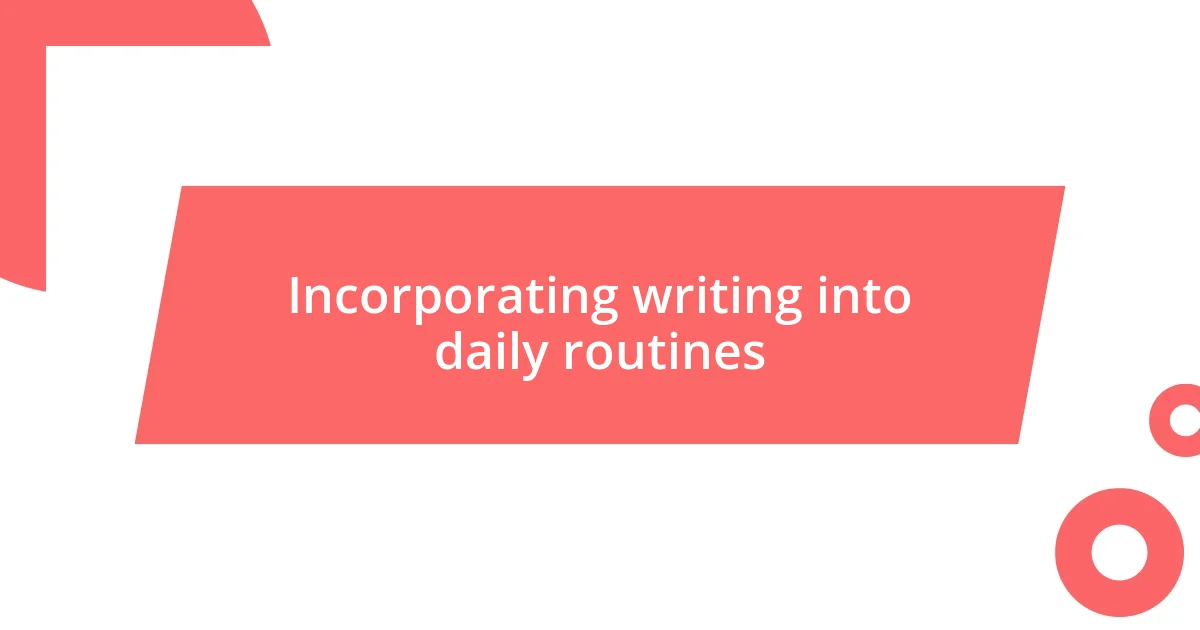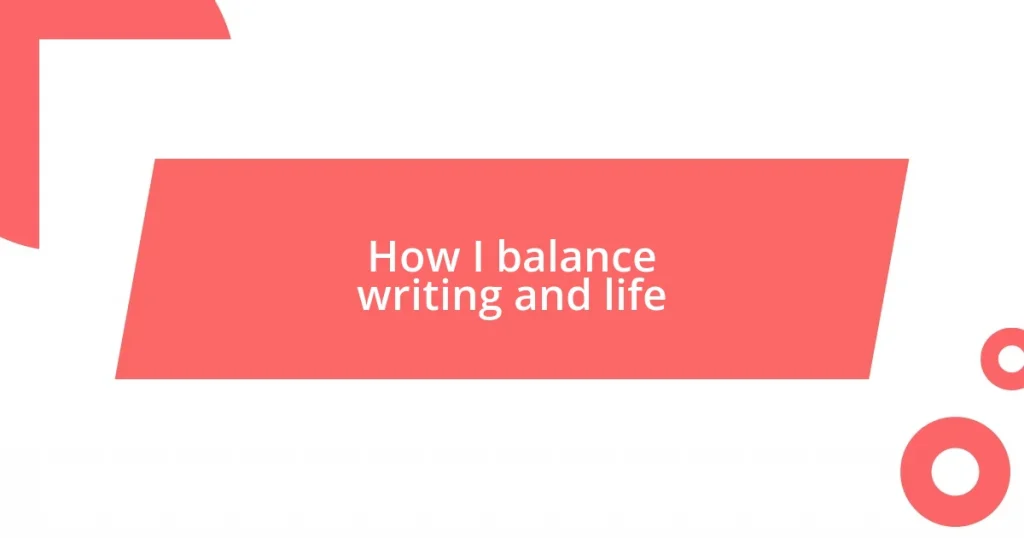Key takeaways:
- Understanding writing priorities involves focusing on topics that resonate with personal passions and adapting to changing interests for enhanced creativity.
- Creating a structured writing schedule through time blocking significantly boosts productivity and accountability compared to unstructured writing practices.
- Incorporating writing into daily routines and setting realistic goals fosters consistency and reduces stress, while leveraging productivity tools and community support enhances motivation and creativity.

Understanding writing priorities
When I first started writing, I often felt overwhelmed by the sheer number of ideas swirling in my mind. I quickly learned that not every idea deserves my immediate attention. For me, understanding writing priorities means determining which topics genuinely resonate with my passions and audience. Have you ever found yourself trapped in an endless cycle of brainstorming without ever committing to a single idea? I have, and it taught me the importance of focusing on what truly matters.
I remember a time when life got chaotic with work and family commitments; I had to step back and reassess my writing goals. Realizing that my energy isn’t infinite, I decided to prioritize projects that aligned with my personal values and current interests. This shift not only helped me produce better work but also reignited my passion for writing. What are the factors that guide your choices in writing?
As I reflect on my writing journey, I recognize that understanding priorities also involves being adaptable. Life changes, and so do our interests; embracing that fluidity can spark creativity. There have been days when I was inspired to write about something completely different, and I allowed myself that freedom. When was the last time you allowed spontaneity to guide your writing? Balancing priorities is about being aware of those moments and seizing them when they come.

Identifying personal time constraints
Identifying personal time constraints can be eye-opening. I vividly recall sitting down with a calendar one Sunday evening, realizing that my writing dreams often collided with day-to-day responsibilities. Between work obligations and family events, I had to face the truth: time is limited, and it’s crucial to take a close look at how I allocate my hours. Have you ever felt like there just aren’t enough hours in the day? That moment of reckoning helped me prioritize my writing sessions, turning them into sacred commitments on my schedule.
To identify your time constraints, consider these factors:
– Work Commitments: Assess regular hours and potential overtime.
– Family Obligations: Factor in family events, responsibilities, and downtime with loved ones.
– Personal Time: Don’t forget to allocate time for self-care and relaxation—it’s vital for creativity.
– Unexpected Responsibilities: Life can be unpredictable, so be prepared for surprises that eat into your writing time.
– Ideal Writing Hours: Identify when you feel most inspired or productive, whether it’s early mornings or late nights.
Determining these constraints not only provides clarity but also empowers me to carve out writing time that feels both attainable and fulfilling.

Creating a structured writing schedule
Creating a structured writing schedule is something I genuinely wish I had figured out sooner in my writing journey. For a while, I wrote whenever inspiration struck, which often left me feeling chaotic and unproductive. I remember those late nights where I’d write furiously, fueled by caffeine, but the next day, I struggled to find coherence in my drafts. Have you ever felt like you’re running in circles without making real progress? What I learned is that structure can lead to enhanced creativity. A consistent schedule transforms writing from a sporadic activity into a rewarding habit.
The pivotal moment came when I experimented with time blocking, dedicating specific chunks of my day to writing. It was surprising how knowing I had a designated hour freed my mind to be more creative. By treating my writing time like an important meeting, I felt a greater sense of accountability. Have you tried time blocking in your own writing? It’s a powerful tool to help you stay focused and ensure that you’re making consistent progress.
| Aspect | Unstructured Writing |
|---|---|
| Flexibility | High – but often leads to chaos |
| Productivity | Inconsistent |
| Creativity | Occasional bursts, but often stifled |
| Focus | Hard to maintain |
| Accountability | Low |
| Emotional Engagement | Frustration and stress |
| Aspect | Structured Writing |
| Flexibility | Moderate – allows for creativity within set times |
| Productivity | Consistent progress |
| Creativity | Flows more freely in structured time |
| Focus | Higher concentration |
| Accountability | Increased commitment to goals |
| Emotional Engagement | Fulfillment and accomplishment |

Incorporating writing into daily routines
Finding ways to incorporate writing into my daily routine has been both challenging and rewarding. I used to think that writing had to happen in large, uninterrupted blocks of time, but I soon realized that even small pockets of minutes can be productive. For me, a quick session with my notebook during my morning coffee became a delightful ritual; those fleeting moments often sparked the seeds of new ideas. Have you ever discovered inspiration in the most unexpected places?
One strategy that worked wonders was carrying a small notebook everywhere. It became my pocket-sized companion, making it easy to jot down thoughts whenever they arose. Whether it was waiting in line or during a commute, these snippets of time added up. I was amazed at how these little chunks of writing could weave seamlessly into my day. It’s like finding the hidden treasures in your routine—have you tried embracing those tiny slices of time?
Moreover, I established a mindful writing practice by setting intentions for my sessions. Instead of feeling the pressure to produce a flawless draft, I shifted my focus to simply enjoying the act of writing. This transformed my approach; it became less about the end product and more about expressing my thoughts. Have you considered approaching your writing with this mindset? Embracing the process allowed creativity to flow naturally without the burden of perfectionism.

Setting realistic writing goals
Setting realistic writing goals is essential for turning abstract dreams into concrete accomplishments. I’ve often seen writers, including myself, set ambitious targets that felt incredibly daunting. For instance, when I first aimed to finish a novel in three months, I overwhelmed myself with pressure. Have you ever felt that pressure where the weight of a grand goal can paradoxically stifle your creativity? I learned that breaking down that daunting goal into smaller, manageable writing milestones made it feel much more achievable, allowing me to celebrate small successes along the way.
Another aspect I’ve found valuable is determining a daily word count that aligns with my schedule and energy levels. Initially, I might have thought that writing 2,000 words a day was the norm, but soon realized that I could only sustain around 500 on a busy day. What if you adjusted your goals to fit your real-life commitments? I began to embrace this reality, which not only led to steady progress but also reduced my stress significantly. The act of writing became something I looked forward to, rather than an obligation that hung over my head.
Moreover, I always find it helpful to revisit and refine my goals regularly. Writing is a fluid process, and what works for you today may not work tomorrow. I used to get discouraged when life situations changed—like a new job or personal challenges—but now I see this adaptability as a strength. What if you approached your writing goals with the flexibility to adjust as you go? Embracing this mindset fosters resilience amid the inevitable ups and downs of life, ultimately fueling my passion for writing rather than extinguishing it.

Leveraging tools for better productivity
Leveraging productivity tools has been a game changer for me. I remember struggling to keep track of ideas and deadlines, feeling like my creativity was scattered everywhere. Then, I discovered apps like Evernote and Trello, which helped me organize my thoughts and tasks in a single place. Have you ever felt overwhelmed by your to-do list? These tools became my lifeline, transforming chaos into clarity and allowing me to focus on writing without distractions.
Another fantastic resource I’ve incorporated into my routine is the Pomodoro Technique, which encourages short, focused bursts of writing interspersed with breaks. Initially, I was skeptical about this approach. Would short sprints really fuel my creativity? But after trying it, I found that those 25-minute sessions not only heightened my concentration but also made me more excited to return to my work after a break. I was amazed at how this structure helped maintain my energy throughout the day, boosting my overall productivity.
Lastly, I’ve discovered the power of online writing communities and forums. Interacting with others who share my passion sparked a newfound motivation in me. I often feel rejuvenated after sharing my work or receiving feedback from fellow writers. Have you ever felt that electric sense of camaraderie when connecting with like-minded individuals? The support and shared insights can provide invaluable inspiration and motivation, creating a sense of accountability that propels my writing forward. Engaging with these communities has taught me that productivity isn’t just about tools; it’s also about fostering relationships that enhance our creativity.

Maintaining work-life balance effectively
Finding a balance between writing and life isn’t a walk in the park, but I’ve figured out a few strategies that really help. For instance, I used to overlook the necessity of setting boundaries—why is it so easy to let work seep into personal time? I made a commitment to stop writing after a specific hour each evening. This decision gave me precious time to unwind, recharge, and indulge in other activities that inspire my creativity, like reading novels or going for long walks.
One memorable experience was when I scheduled a dedicated “writing day” each week. I would treat it like a mini-retreat; isolating myself from distractions and really immersing in my work. The thrill of knowing I had that block of quality time dedicated solely to writing reframed how I viewed my creative process. I often think, isn’t it fascinating how giving myself permission to indulge in focused writing can elevate my mood and productivity? Those designated days became something I eagerly anticipated, reducing stress and reigniting my passion for storytelling.
I also learned the importance of self-care in maintaining my work-life balance. Initially, I resisted taking breaks, believing they interrupted my flow—have you ever thought that way too? But stepping back and engaging in activities I love, like cooking or spending time with friends, has greatly improved my clarity and creative energy. It’s astonishing how refocusing on life outside of writing can sometimes lead to my best ideas and moments of inspiration. Balancing these elements nurtures my mental well-being, making me a better writer and a happier person overall.















